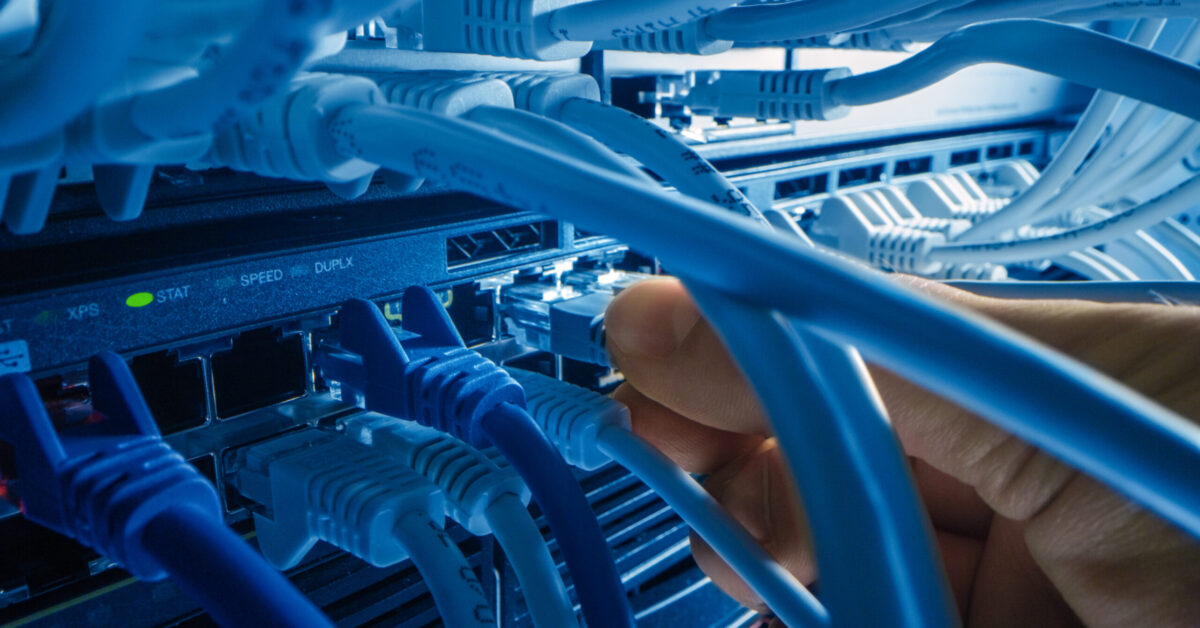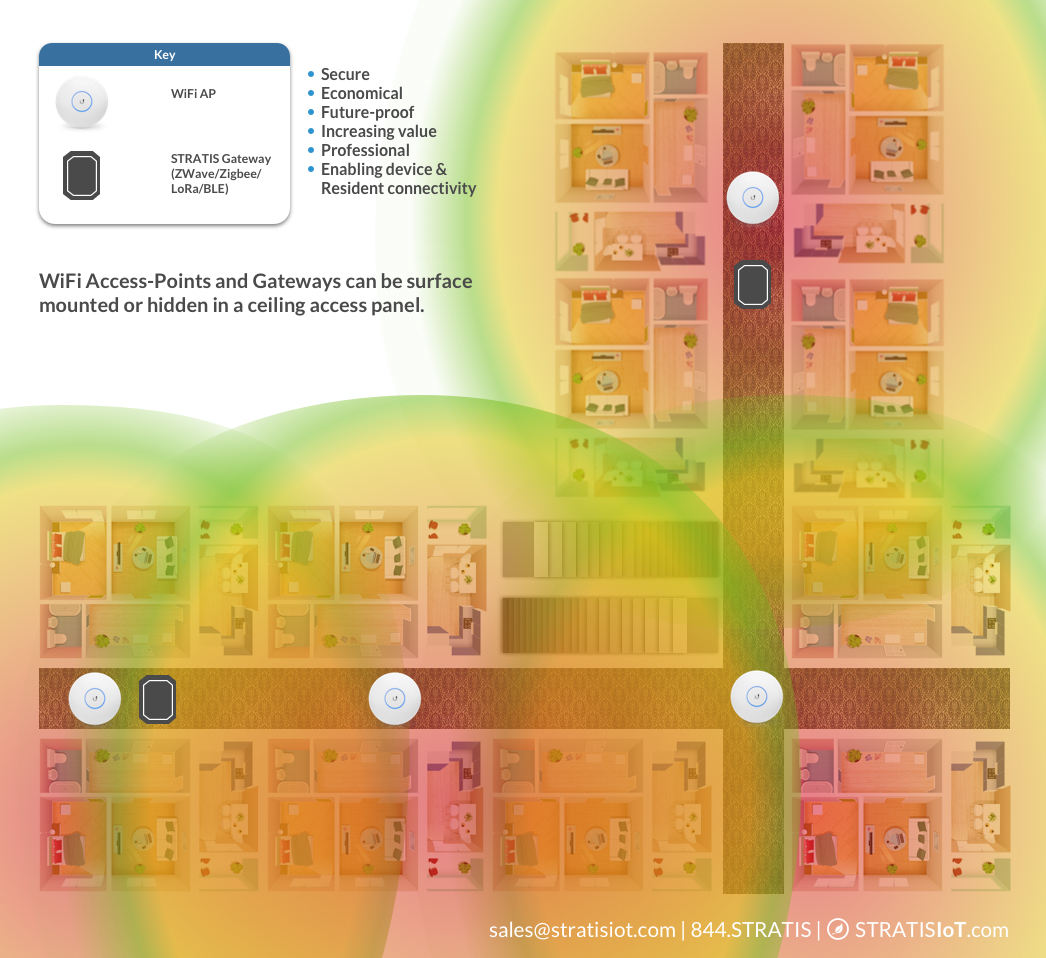
5 Questions to Ask About Smart Apartment Networks
There is a rapidly growing number of companies that claim to provide Smart Apartment network solutions, which can make it difficult to properly evaluate each product. The core difference between these solutions is the method of providing connectivity and a network. Providers typically establish Smart Apartment wireless networks through unit-based connectivity or a building-wide network infrastructure.
What do “unit-based connectivity” and “building-wide network infrastructure” mean for Smart Apartment wireless networks?
A wireless network, regardless of the connectivity method, enables smart devices (like smart thermostats, smart leak sensors, and more) to connect to and communicate back to a cloud platform.
With unit-based connectivity, an access point/hub (like a Wi-Fi router or Z-Wave hub) provides internet and connects smart devices near it. For example, a smart thermostat in a single-family home would usually connect to a Wi-Fi router, which is a unit-based connectivity solution. In multifamily housing, many Smart Apartment vendors place a Z-Wave hub in each apartment unit to connect to the smart devices in the unit.
With a building-wide network infrastructure, there are multiple access points/hubs mounted in common areas, such as hallways, that communicate between each other and the smart devices across the property. A property-wide wireless network connects smart devices across the whole building, instead of a unit-based connectivity “hub per unit” approach with each hub only connecting to smart devices in each apartment unit. The diagram below shows how a Smart Apartment building-wide network installation provides connectivity in multifamily. The hubs (or access point and gateway) overlap in the areas they cover to provide a strong connection across the property, including the apartment units and common areas).

The specific differences between the unit-based connectivity method and building-wide network method can be hard to understand, so here we break them down into five main points: 1) facility capabilities, 2) cost, 3) longer-term value, 4) resident connectivity, and 5) security.
1. What are the capabilities?
Within a property, Property Staff often need to adjust common area and vacant unit temperatures or lighting. If the property has unit-based connectivity, Property Staff must physically enter each area change any settings. Also in this case, Residents are typically responsible for providing their own hub, like their own Wi-Fi router. When the Resident moves out and the Wi-Fi router is no longer in the apartment unit, the smart devices can’t work, and Property Staff can’t control the vacant unit. However, some solutions providers offer cellular backup modems, to continue to provide a network to connect the smart devices. Ask your solutions provider if there are any additional cell subscription costs, and consider the the cell modem’s reliability, especially in low-cell connectivity areas.
With a building-wide network, there is building-wide connectivity, that isn’t dependent on a Resident installing Wi-Fi in their unit. This wireless coverage includes apartment units, common areas like hallways and amenity areas, leasing offices, and beyond. The Property Manager can also easily automate and control devices (like smart thermostats, smart lighting, smart leak sensors, etc) for vacant units and common areas. This increases energy efficiency and net operating income.
2. What are the costs?
The unit-based connectivity method can cost about $70 to $160 per hub, typically with a hub per each apartment unit and several in common areas.
The building-wide network uses fewer hubs, as each hub can cover multiple units. However, unlike unit-based connectivity, the building-wide network installation includes costs for cabling, network switches and firewalls, and professional installation.
The two connectivity methods are typically the same overall expense. But, the building-wide network installation increases the long-term value of the building, which will be explained in the section below.
3. What is the long-term value?
The unit-based connectivity method is often dependent on the Resident’s hub (ex. A Wi-Fi router), so this is not a true permanent network infrastructure.
Implementing Smart Apartment technology is an investment by Property Owners, which is recognized in the building’s valuation. STRATIS’s professionally installed building-wide network infrastructure future-proofs the building, and increases the value of a building for its lifetime. All smart devices have guaranteed connectivity. Also, when Property Owners purchase this style of network, it can be treated as an upfront expenditure, so when they sell this building in the future, the technology value can increase the sell-price.
4. How can residents connect to the network?
The unit-based connectivity method provides wireless connection in apartment units where Residents have installed a hub (ex. A Wi-Fi router), but leaves common areas and other non-unit areas of the property without internet.
Building-wide networks can enable connectivity in common areas with Wi-Fi. If requested for new developments, STRATIS installs high-speed infrastructure (Cat6). This will last the lifetime of the unit and building, so it is a sustainable future-proofing option. For Residents, this takes out the hassle of selecting and installing Wi-Fi in their unit.
5. How secure is the platform?
Unit-based connectivity is based on the networking method you would typically see in a single-family home, and many smart devices that connect with these hubs are made for the single-family market. This has some serious security concerns, because there are major differences between the ways people live in and move through single-family versus multifamily housing.
- Hubs for unit-based connectivity are usually not professionally managed, and will rarely have the intrusion prevention/detection of a professionally installed network. If a hacker attacks that Resident’s network, the hub and its connected devices are all at serious risk.
- Residents or other people who have access to the unit could accidentally or intentionally tamper with the hub. This can reset the network and disconnect all previously connected smart devices with the external factory reset capability. Also, physical access to the hub removes basic security hurdles, making it much easier for hackers to enter into the network.
A professionally-installed building-wide network infrastructure resolves these problems. By implementing Security Gateways (aka “Firewall”), Intrusion Prevention, and Intrusion Detection, only vetted employees and contractors can access the network equipment. In addition, STRATIS monitors our networks for security and connectivity from a centralized portal, so there’s an immediate alert if a gateway, hubg, or Wi-Fi access point falls off the network for any reason.
Multifamily and Student Housing are unique markets that require unique solutions. STRATIS provides secure and cost-effective property-wide IoT solutions that last a lifetime and significantly upgrade the quality of the building. With these five questions, you are equipped to to evaluate Smart Apartment network infrastructure. Digging into these five areas with a potential solutions provider is crucial as this could be an investment in a facility-wide approach that will last a building’s lifetime.
To learn more about secure smart apartment networking and IoT in general, here is an article by Lesley Carhart, a trusted cybersecurity specialist.
STRATIS®, a RealPage Company, creates smart apartments and intelligent buildings and is the only platform of its kind built for the complexities of multifamily and student housing. STRATIS is installed worldwide across the U.S., in Japan, the UK, EU, and Latin America. STRATIS now serves hospitality, retail, and small to mid-size commercial, as well. STRATIS is an Inc. Magazine “Fastest Growing Company in America” and a Top Ten Entrepreneur Magazine “Best Company in America.” STRATIS was recently acquired by RealPage to enable STRATIS Smart Building, a more connected lifestyle, and unleash hidden yield through new revenue streams.
STRATIS®, a RealPage Company, creates smart apartments and intelligent buildings and is the only platform of its kind built for the complexities of multifamily and student housing. STRATIS is installed worldwide across the U.S., in Japan, the UK, EU, and Latin America. STRATIS now serves hospitality, retail, and small to mid-size commercial, as well. STRATIS is an Inc. Magazine “Fastest Growing Company in America” and a Top Ten Entrepreneur Magazine “Best Company in America.” STRATIS was recently acquired by RealPage to enable STRATIS Smart Building, a more connected lifestyle, and unleash hidden yield through new revenue streams.